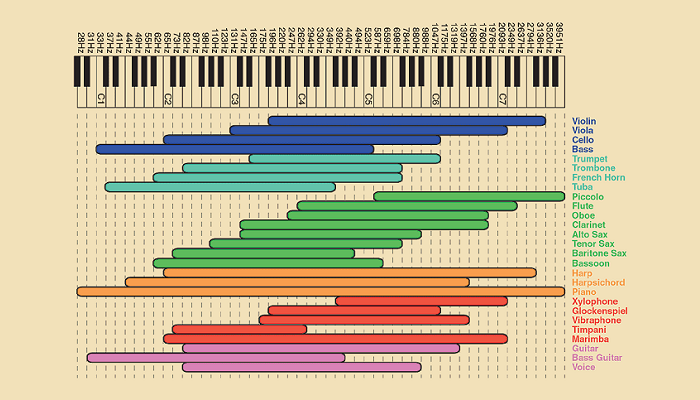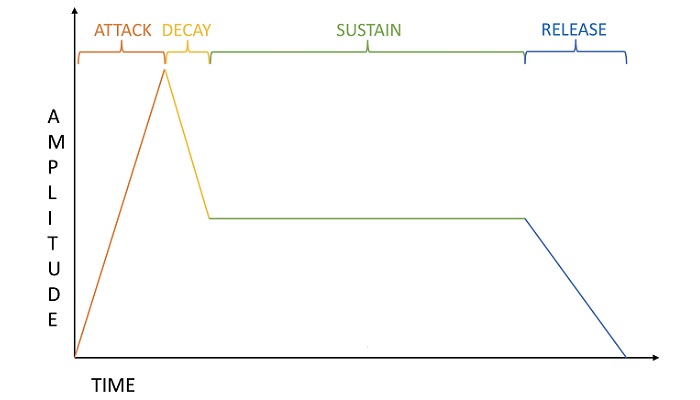Have you ever wondered how these different sounds can be produced only by playing one tone? It’s the magic of timbre. Generally, timbre is the tone of a particular sound, whether an instrument or a person.
It’s easy to recognize someone’s sound when you’re close to them. The same goes for music. If you’re familiar with a sound, you’re going to pick up its timbre right away.
In music, there’s a different sound, or timbre, for each instrument. Differentiating between each one takes time and practice.
While it’s way easier with people, you’ll be in trouble if you can’t identify a close person’s voice in a minute, and I can’t help you with this one.
What Is Timbre In Music?
Timbre is usually referred to as “tone quality.” On the surface, you might say it’s pretty self-explanatory, but that’s only scratching the surface.
Basically, timbre is how we distinguish between different sounds using certain characteristics and techniques that define them.
How Timbre Is Created
As we mentioned, timbre mainly comes from the sound of a particular instrument or a person. In this section, we’ll focus on instruments to get an idea of the different ways timbre is produced.
Let’s put it into examples for a better understanding. Say you’re walking down the street and hear someone calling your name. Whether you decide to stop and say hello or keep walking depends on the sound of their voice.
That’s timbre. It’s the unique characteristic of an instrument that allows you to distinguish it from others, creating new pieces and expressing more ideas and emotions.
Timbre can be a nightmare for many musicians. Nevertheless, all it takes is a bit of perseverance mingled in with a whole lot of practice. Eventually, distinguishing between timbres becomes second nature.
Many musicians, whether singers, instrumentalists, or even music students, have struggled to grasp the concept of timbre. It’s frustrating because it can be such a barrier to a lot of creative pieces.
Timbre, or tone quality, depends on two elements: frequency and overtones. These are what make it possible to produce a different sound from playing the same tone. Understanding these two elements is the first step toward achieving a flawless sound.
Frequency

Through frequency, we can distinguish one instrument from another. Yet, where does it come from?
All instruments create vibration to make a particular sound. This vibration produces a large number of repeated sound waves in one second, which is what we call frequency.
Moreover, because all the instruments vibrate slightly differently, each has different frequencies. Different frequencies produce different timbres.
Overtones
The other fundamental element that builds up a timbre is overtones. They work hand-in-hand with frequencies to create the various sounds and timbres we hear.
Overtones are a series of frequencies that instruments produce. It’s also called the harmonic series.
As the name suggests, you can tell that its main job is to create sound waves. Thus, overtones are responsible for the characteristic sound made by every instrument.
So, if you hear a professional guitarist playing a metallic tone in a crowded party or a beginner band student crashing cymbals together. If you hear a pen hitting the floor in a classroom or a car honking its horn, they’re all different forms of timbre.
In a matter of seconds, each particular harmonic frequency hits our ears. Thus, we can identify it almost instantly and recognize what’s making that particular sound.
How Timbre Uses Different Sounds that Make Us Feel

Music is not just a set of tones with no purpose. It serves the purpose of changing our moods. How many times have you listened to a few chords only to find yourself feeling happy, sad, or scared out of your wits.
That’s the power of music!
Have you ever heard a foreign song and felt like it sounds familiar, even though you don’t understand a single word? Or spent the night crying your eyes out to a European song without knowing one word of it or even the story behind it?
If you have, congratulations! You’ve just experienced the magic of timbre.
It’s when you feel the musical piece and relate to it with your body, not only your mind. That’s probably one of the most challenging parts for any musician.
As a musician, you know you’ve reached an agreement with timbre when your audience can connect with your music on a personal level.
When they’re able to describe what they’re hearing as warm, lively, or somber. That gives you the satisfaction and validation that push you forward to the next level.
Timbre and Emotions
So, we can say that the timbre is a combination of the tone and the quality of a particular sound. Together, they help get the meaning across. Here are some popular ways to define timbre.

- Harsh: the sound of distorted electric guitars, snare drums, cymbal crashes, sawtooth waves.
- Soft: describes sound made by recorders, quiet piano notes, timpani rolls, French horns.
- Ready: describes the windy sounds made by the oboe, clarinet, bassoon, cor anglais.
- Brassy: commonly used to describe the sound of trumpets, trombones, and tubas.
- Bright: describes the sound of a piccolo, hi-hat, trumpet, and oboe.
- Dull: can describe different notes, but the most common is the Floor tom.
Timbre and Sound
The following are used to describe the diverse characteristics of sound produced by various timbres.
- Tremolo: describes the sudden change in volume caused by changes in sound wave frequency.
- Breathy: describes quiet sounds lacking in resonance or abrupt frequency changes.
- Vibrato: refers to the slight vibration that happens in the shifting pitches.
- Nasal: refers to the combination of the loud basic pitch with minimal overtones.
- Raspy : describes the lower pitch of breathy sounds, as well as scratchy, rough sounds.
- Metallic : describes free loud tones typically produced by the guitar and drums.
- Distorted: refers to the sound waves where you can hear the deep middle frequencies.
- Noisy: this is when basic pitches aren’t balanced and mainly depends on the overtones.
- Thick: refers to sound produced by blending several overtones and melodies and playing them at the same time.
Different Instruments and Their Timbre
We’ve gone over the basics in terms of definitions and jargon. Now, it’s time to go into more detail. Keep reading to fully grasp the concept of waves and sounds.
Electric and Acoustic Guitars

You can immediately notice the difference in guitar timbres based only on their type, whether electric or acoustic.
Guitars are considered the most obvious when it comes to timbre. Nonetheless, there are a lot more variances and undertones.
This is more common with electric guitars due to their development over the years. For example, guitarists can adjust the tone’s brightness using the tone wheel. Not many instruments have that wide level of control, so it’s a handy feature to have.
Woodwind And Brass
The timbre differences in woodwind and brass timbres are controlled by the instrument’s material. They also depend on how the player handles and controls the amount of air is blown into the instrument to create a particular resonance.
So, we can say that blowing in a trumpet produces a different timbre to buzzing into a flute. The first sound would be described as soft, whereas the other one would sound light and airy.
Vocals
It makes sense that this would be the broadest range of timbres. As we mentioned, you can identify any person’s voice in under a few minutes as long as you’re familiar with it.
Besides the obvious tone difference between genders, you can notice more significant differences just by hearing one word. For example, you can tell whether you’re getting a promotion or you’re getting fired, simply by the tone in your boss’s voice.
String Instruments

Unlike guitars, it’s not that easy to control the brightness of a tone with a violin or a cello. The best you can do with strings is work on your technique. This gives you the freedom of creating different timbres.
Percussion
The percussion family includes drums, xylophone, tambourine, and cymbals. Have you ever noticed how they produce a mix of sounds that seem to blend together perfectly?
For example, in a drum kit, you can hear almost all the timbre techniques we mentioned earlier. It may be a bit difficult to identify them if you’re not a musician, but you’ll have no trouble enjoying them for sure.
Factors That Affect Timbre
Professional musicians tend to get creative with the way they develop timbres. Being creative means allows them to produce a variety of timbres in unique ways. This helps distinguish them, and gives their work a unique sound.
By now, you know that timbre depends on the type of instrument, as well as each player’s technique. However, there are also a few external factors that affect how timbre is produced and made.
Forced Air
Forced air is mainly used in instruments like oboe, trumpet, or flute. With these instruments, the way you push the air through is everything.
You can be as creative as you want. Just be careful because if you mess up a note, you risk ruining the timbre.
The Shape of an Instrument

Every instrument shape is known to produce different frequencies. For example, cymbals are always described as loud and harsh, while trumpets are bright and brassy.
This is one of those things you can’t control. The only thing you can do is learn to master your instrument’s techniques and hope for the best.
Posture
The number one lesson in anything related to music is posture. Your whole musical career depends on it, whether you’re a singer or an instrumentalist.
If you’re a singer, you have to pay close attention to how you sit, move, and stand. Poor posture encourages you to use extra muscles to sing. Over time, this strains your muscles, weakens your posture, and can even affect your voice.
If you play any instrument, you have to maintain a specific position. Violinists, for example, keep their shoulders upright. On the other hand, cellists have to hold up their backs and arms. Without proper posture, you won’t be able to produce the right timbre.
Breath Control
Have you ever seen a basketball player who can’t catch the ball? Breath control to a musician is what a ball is to a player.
It doesn’t matter if you’re a singer, a trumpeter, or play a woodwind instrument. Controlling your breath is a crucial part of your trade.
Sound Envelope

If you’re wondering how this is related to the timbre, here’s a brief explanation: sound envelope is one of the main factors that can affect the tone of an instrument.
It’s the process of completing a note. Starting from complete silence, then going to its peak, and then to nothing again.
Every instrument goes through a different process of producing sounds from start to finish. Therefore, every instrument has a different envelope.
This explains how the same piece can be played faster or slower. It also explains how a singer can sing the same song utterly different from the other and still sound good. It wouldn’t be possible if the composers and performers didn’t understand the art of the ADSR envelope.
The envelope of the sound explains the changes of a particular note over time. It has four main aspects: Attack, Decay, Sustain, Release.
Let’s talk about each one in detail.
- Attack: the time a note takes to shift from barely audible to peak loudness.
- Decay: refers to how long a note takes to go from peak loudness to prominent loudness.
- Sustain: the state of a note where it lasts at its main loudness till the playing stops.
- Release: the amount of time a note takes to become silent after the playing stops.
Different Types of Timbre

Different timbres are created to complement different pieces of music. There are four types of timbre: harmonic, polyphonic, monophonic, and accompanied.
- Harmonic: used when the composer harmonizes musicians by playing the same rhythm.
- Polyphonic: creates a blend of musical tones.
- Monophonic: creates a single melodic line, more common in Western European music.
- Accompanied: produces a musical piece adding the best quality of every instrument.







